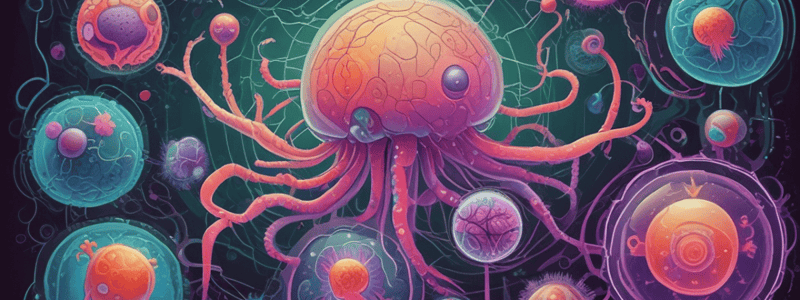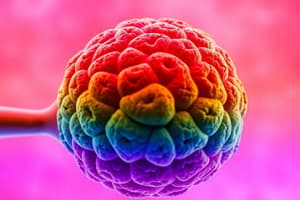Podcast
Questions and Answers
What is the primary consequence of cancer cells being diagnosed late?
What is the primary consequence of cancer cells being diagnosed late?
- Increased chance of successful treatment
- Higher risk of metastasis (correct)
- Reduced risk of invasion
- Increased risk of encapsulation
What is the mechanism of action of alkylating agents in chemotherapy?
What is the mechanism of action of alkylating agents in chemotherapy?
- Modification of DNA structure (correct)
- Inhibition of dihydrofolate reductase
- Induction of apoptosis
- Inhibition of DNA synthesis
Which type of chemotherapy is specific to the M-phase of the cell cycle?
Which type of chemotherapy is specific to the M-phase of the cell cycle?
- Glucocorticoids
- Vinca alkaloids (correct)
- CDK inhibitors
- Taxanes
What is the primary function of death receptors in cancer cells?
What is the primary function of death receptors in cancer cells?
What is the characteristic of invasive cancer cells?
What is the characteristic of invasive cancer cells?
What is the primary mechanism of action of mercaptopurine?
What is the primary mechanism of action of mercaptopurine?
What is a key aspect of cancer development that treatment strategies should take into account?
What is a key aspect of cancer development that treatment strategies should take into account?
What is a primary goal of cancer treatment strategies?
What is a primary goal of cancer treatment strategies?
What is a key aspect of antibacterial therapy?
What is a key aspect of antibacterial therapy?
What is the primary mechanism of action for β-Lactam Antibiotics?
What is the primary mechanism of action for β-Lactam Antibiotics?
Which of the following medications is used to treat Methicillin-resistant Staphylococcus aureus (MRSA)?
Which of the following medications is used to treat Methicillin-resistant Staphylococcus aureus (MRSA)?
What is the function of DNA gyrase in prokaryotic DNA replication?
What is the function of DNA gyrase in prokaryotic DNA replication?
What is the primary difference between bacteriostatic and bactericidal antibiotics?
What is the primary difference between bacteriostatic and bactericidal antibiotics?
What is the function of DnaA in prokaryotic DNA replication?
What is the function of DnaA in prokaryotic DNA replication?
Why has the use of sulphonamides decreased over time?
Why has the use of sulphonamides decreased over time?
Which of the following resources provides information on drug-drug interactions, side effects, and combinations?
Which of the following resources provides information on drug-drug interactions, side effects, and combinations?
What is the mode of action of nalidixic acid?
What is the mode of action of nalidixic acid?
What is the significance of identifying differences between host and pathogen?
What is the significance of identifying differences between host and pathogen?
What is the common side effect of nalidixic acid?
What is the common side effect of nalidixic acid?
What is the rationale behind infective drug design?
What is the rationale behind infective drug design?
What is the challenge in antibiotic therapy?
What is the challenge in antibiotic therapy?
What is the concept of risk versus benefit in drug prescription?
What is the concept of risk versus benefit in drug prescription?
Pro-caspase 8 is activated by proteolytic cleavage in the intrinsic pathway.
Pro-caspase 8 is activated by proteolytic cleavage in the intrinsic pathway.
Caspase 3 is activated by caspase 9 in the extrinsic pathway.
Caspase 3 is activated by caspase 9 in the extrinsic pathway.
BAX, BAD, and BID are proteins that inhibit apoptosis.
BAX, BAD, and BID are proteins that inhibit apoptosis.
DNA damage causes rapid p53 phosphorylation and inhibition.
DNA damage causes rapid p53 phosphorylation and inhibition.
CD95L is involved in the intrinsic pathway of apoptosis.
CD95L is involved in the intrinsic pathway of apoptosis.
Pro-caspase 9 is activated by caspase 8 in the intrinsic pathway.
Pro-caspase 9 is activated by caspase 8 in the intrinsic pathway.
Tailoring treatment strategies to distinctive features of cancer cells is not a viable approach.
Tailoring treatment strategies to distinctive features of cancer cells is not a viable approach.
Antibiotics are a type of anti-infective that targets cancer cells.
Antibiotics are a type of anti-infective that targets cancer cells.
Metastasis occurs when cancer cells move inside a tumour 'capsule'
Metastasis occurs when cancer cells move inside a tumour 'capsule'
Glucocorticoids are a type of antibiotic used in chemotherapy
Glucocorticoids are a type of antibiotic used in chemotherapy
Inhibiting Dihydrofolate reductase is a mechanism of action of alkylating agents
Inhibiting Dihydrofolate reductase is a mechanism of action of alkylating agents
Vinca alkaloids are cell cycle nonspecific chemotherapy agents
Vinca alkaloids are cell cycle nonspecific chemotherapy agents
Mercaptopurine is a CDK inhibitor
Mercaptopurine is a CDK inhibitor
Death receptors trigger apoptosis when DNA is damaged
Death receptors trigger apoptosis when DNA is damaged
Ceftaroline is a type of β-Lactam Antibiotic that is used to treat methicillin-sensitive Staphylococcus aureus (MSSA).
Ceftaroline is a type of β-Lactam Antibiotic that is used to treat methicillin-sensitive Staphylococcus aureus (MSSA).
Sulphonamides are a type of bactericidal antibiotic that inhibits nucleic acid synthesis.
Sulphonamides are a type of bactericidal antibiotic that inhibits nucleic acid synthesis.
DNA ligase is an enzyme that introduces negative supercoils into a relaxed closed circular DNA molecule.
DNA ligase is an enzyme that introduces negative supercoils into a relaxed closed circular DNA molecule.
Cotrimoxazole is a combination of a sulphonamide and a β-Lactam Antibiotic.
Cotrimoxazole is a combination of a sulphonamide and a β-Lactam Antibiotic.
DnaB is an enzyme that synthesizes RNA primers during prokaryotic DNA replication.
DnaB is an enzyme that synthesizes RNA primers during prokaryotic DNA replication.
Penicillins are a type of β-Lactam Antibiotic that can be used with or without a beta-lactamase inhibitor.
Penicillins are a type of β-Lactam Antibiotic that can be used with or without a beta-lactamase inhibitor.
Flashcards are hidden until you start studying
Study Notes
Targeting Replicating Cells
- Cancer development: involves cells that move outside a tumour "capsule" and cause metastasis through the body
- Cancer diagnosis: often late, resulting in a high chance of metastasis
- Chemotherapy: targets cell cycle, modifying DNA structure, inhibiting DNA synthesis, and inhibiting protein synthesis
Cell Cycle Inhibitors
- Alkylating agents: modify DNA structure
- Antibiotics: inhibit DNA synthesis
- Inhibit DNA polymerase: prevent DNA replication
- Inhibit Dihydrofolate reductase: prevent DNA synthesis
- Inhibit thymidylate synthetase: prevent DNA synthesis
- Inhibit topoisomerase: prevent DNA synthesis
- Steroid hormones and antagonists: target specific proteins (e.g. glucocorticoids, anti-oestrogens, androgens/anti-androgens)
- M-Phase Specific: Vinca alkaloids, M Taxanes
- Cell cycle inhibitors: CDK inhibitors, S Purines, Pyrimidines
- Many drugs not cell cycle specific: target specific proteins (e.g. G0, monoclonal antibodies, inducers of ROS, etc.)
Death by Apoptosis
- Cell death: involves death receptor (e.g. CD95)
- CD95L: extrinsic pathway, activates caspase 3, 6, 7, and leads to DNA degradation
- DNA damage: activates p53, which phosphorylates and activates BAX, BAD, and BID, leading to apoptosis
- Intrinsic pathway: involves DNA damage, p53 activation, and BAX, BAD, and BID activation
Anti-Infectives
- Antibiotics: target bacterial cell wall synthesis, nucleic acid synthesis, and protein synthesis
- Inhibition of cell wall synthesis: β-Lactam antibiotics, cephalosporins, carbapenems, and monobactams
- Inhibition of nucleic acid synthesis: sulphonamides, trimethoprim, cotrimoxazole-combo
- Inhibition of protein synthesis: tetracyclines, aminoglycosides, macrolides, and chloramphenicol
- Bacterial DNA replication: requires proteins DnaA, DNA gyrase, DNA ligase, DnaB, DnaC, DNA polymerase III, and DnaG (primase)
- DNA Gyrase Inhibitors: target bacterial DNA gyrase, necessary for DNA synthesis
Studying That Suits You
Use AI to generate personalized quizzes and flashcards to suit your learning preferences.




